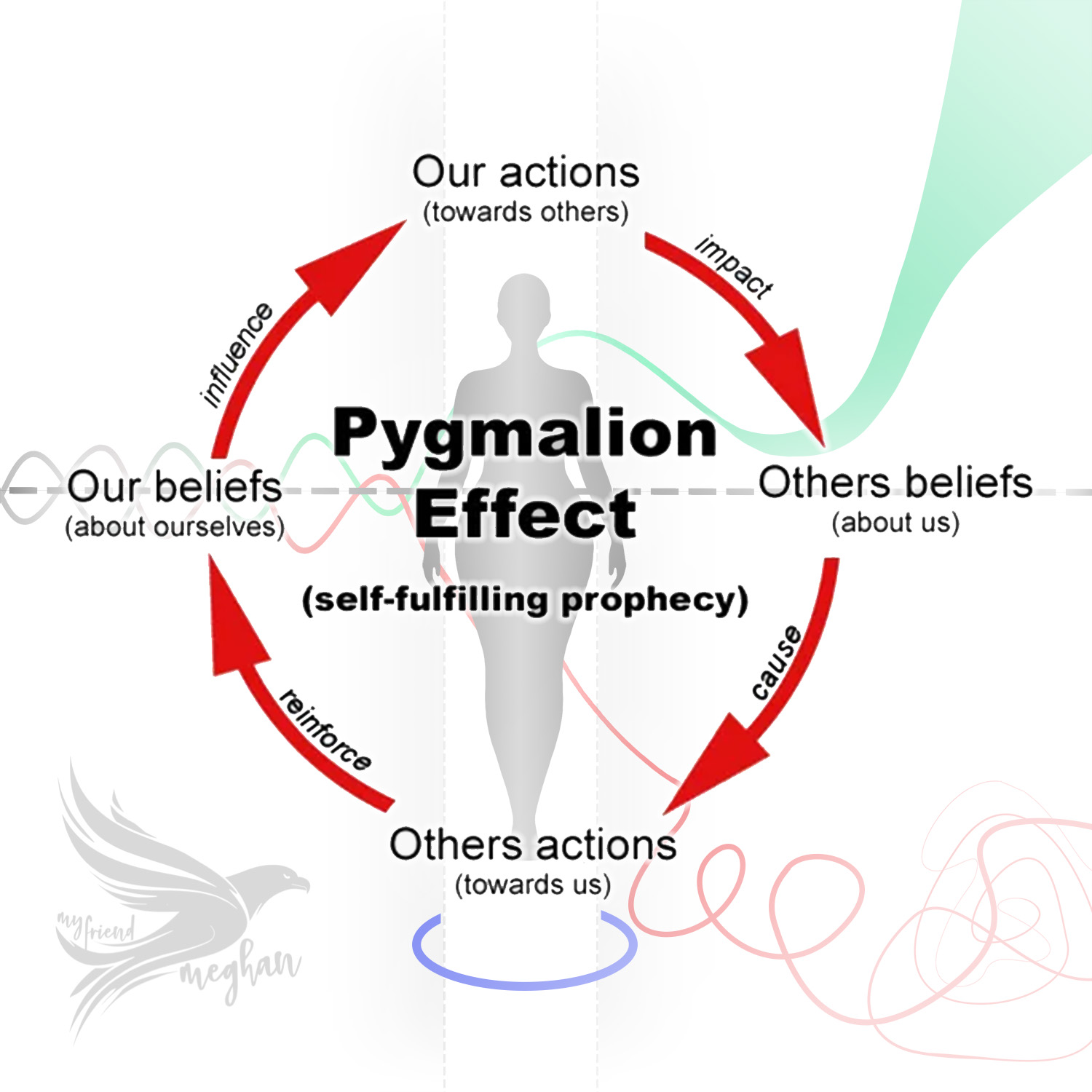Have you ever noticed how your expectations influence the way things unfold? Whether it’s how people treat you or the opportunities that come your way, there’s a powerful connection between what we believe and the reality we create. This phenomenon is known as the Pygmalion Effect, often described as a self-fulfilling prophecy. For years, I’ve been fascinated by this concept. In 2003, I wrote a blog post about taking thoughts captive (ungodly beliefs). At the time, I focused on how the Pygmalion Effect—the idea that our beliefs influence reality—often reinforced negative cycles. At the time, I saw this principle as a cautionary tale: unchecked, our limiting beliefs could spiral into self-fulfilling prophecies that worked against us.
What I’ve come to realize over the years, however, is that this principle isn’t inherently negative or positive. It’s a universal truth. The power lies in our ability to shift the polarity. We get to choose the polarity of our perspective. When we intentionally align our thoughts and actions with what we want to create, the same cycle that once reinforced limitations can become a catalyst for growth, success, and fulfillment. Understanding this dual potential is what makes the Pygmalion Effect a powerful tool for transformation.
The Pygmalion Effect & Manifesting
While the Pygmalion Effect is often discussed in the context of interpersonal dynamics—how our beliefs about others shape their responses to us—it has a much broader application. At its core, the Pygmalion Effect reveals the power of expectation: the way our thoughts and beliefs influence outcomes. This universal principle aligns closely with the concept of manifestation, which is a recurring theme in intentional living practices.
Manifestation teaches that our thoughts and energy shape our reality. The Pygmalion Effect gives this idea a psychological framework, demonstrating how belief-driven actions create feedback loops that reinforce those beliefs. Whether the focus is on others or ourselves, this dynamic operates the same way:
- Believing someone is capable of achieving a goal leads us to offer encouragement and support, which often inspires them to believe in themselves and put in greater effort and succeed, reinforcing our belief in their ability.
- Believing someone doesn’t like you can lead to guarded or defensive behavior, which may create tension and encourage the very feelings you feared. Conversely, believing people will treat you with respect and care can lead to openness and warmth, which draws out similar behavior in others, increasing the likelihood of positive interactions.
The neutrality of the Pygmalion Effect makes it especially powerful in manifesting. The cycle itself is neither inherently positive nor negative—it simply reflects and magnifies the energy we feed into it. This is where cultivating Elevated Thought becomes essential, as it helps us redirect our focus and align our beliefs with a higher perspective. When we intentionally direct our beliefs toward positive outcomes, the Pygmalion Effect works in harmony with manifestation to help us co-create a reality that reflects our highest good and allows us to be both blessed and a blessing to the greater whole.
In-depth Exploration of Key Concepts
The Pygmalion Effect demonstrates how our beliefs, actions, and outcomes create a continuous feedback loop, shaping both our internal and external realities. This cycle can reinforce limiting beliefs—or, when intentionally aligned with positive expectations, empower us to create meaningful change.
This principle aligns closely with two steps from the Intentional Living framework: cultivating an expectation of good and assuming positive intent. Both steps emphasize the power of our beliefs to shape outcomes, whether in our interactions with others or in our own self-concept. For a deeper dive into this process, you can explore the Intentional Living overview.
Here’s the core framework of the Pygmalion Effect:
- Our Actions (towards others): The way we behave towards others stems from our internal beliefs. For example, if we believe we’re unworthy, we might act hesitantly or avoid connection. Impact: These actions influence how others perceive us.
- Others’ Beliefs (about us): Our actions shape others’ expectations and perceptions. If we approach them with confidence, they’re likely to believe in our capability. If we act uncertain, they may question our competence. Cause: These beliefs lead others to act accordingly.
- Others’ Actions (towards us): People’s actions reflect their perceptions of us, often reinforcing the beliefs we initially projected. For instance, encouragement can affirm our confidence, while doubt can validate our insecurity. Reinforce: These responses strengthen our internal beliefs.
- Our Beliefs (about ourselves): The feedback we receive from others confirms or challenges our self-perception. Over time, this shapes our confidence, outlook, and behavior. Influence: These beliefs cycle back to shape our actions.
The Key Insight: Polarity Matters
Again, what makes the Pygmalion Effect so powerful is its neutrality. The cycle itself is neither inherently positive nor negative—it reflects and amplifies whatever energy we put into it, which is why choosing your perspective polarity with care and intention is so essential, as it directly impacts the energy we bring to the cycle. If we allow negative or limiting beliefs to dominate, the cycle will work against us.
But when we consciously redirect our thoughts and actions toward positive outcomes, the same mechanism begins to work for us.
Why This Matters
A helpful way to understand this dynamic is through the concept of interest:
- If you owe money and are paying interest on a debt, the cost compounds over time, creating an increasing burden.
- Conversely, if you’ve invested money and are earning interest, your gains compound, creating growing abundance.
The cycle itself—whether financial interest or the Pygmalion Effect—is neutral. It simply amplifies what is put into it. When we feed the cycle with limiting beliefs, it reinforces those constraints. But when we intentionally shift our thoughts and actions toward positivity and possibility, the same cycle works in our favor, compounding growth, confidence, and success. Recognizing this truth allows us to take control and use this principle as a powerful tool for transformation.
Conclusion
The Pygmalion Effect is a universal principle that offers us the opportunity to shape our reality. Whether it works for or against us depends on what we feed into it. By becoming mindful of our thoughts, we can shift from reinforcing limiting patterns to creating self-fulfilling prophecies that align with our highest potential.
Choosing perspective polarity intentionally—by capturing negative thoughts and rewriting false beliefs are powerful practices that allow us to shift the cycle in our favor. When we approach this process with intention, we can transform not only our own beliefs but also how others respond to us, creating a ripple effect of positive change.
Actionable Insights
- Take your thoughts captive. Pay attention to the beliefs driving your actions. When you notice negative or limiting thoughts, pause. Challenge them by asking, “What is the truth here?” Then consciously choose a more empowering thought to focus on.
- Reframe limiting beliefs. Identify one belief that feels constrictive, such as “I’m not capable.” Replace it with a positive counterpart, such as “I am growing every day.” Notice how shifting this belief influences your actions and others’ responses.
- Experiment with positive reinforcement. Identify one interaction today—whether a conversation, task, or decision—where you will act with full confidence in a positive outcome. For example, approach a conversation with the belief that it will go smoothly. Reflect on how your actions impact the dynamic.
- Shift the cycle to work for you. Identify an area of life where the Pygmalion Effect may be reinforcing negativity—whether in relationships, work, or personal goals. Write down one action you can take to reverse the cycle and move toward positive outcomes.


Leave a Reply